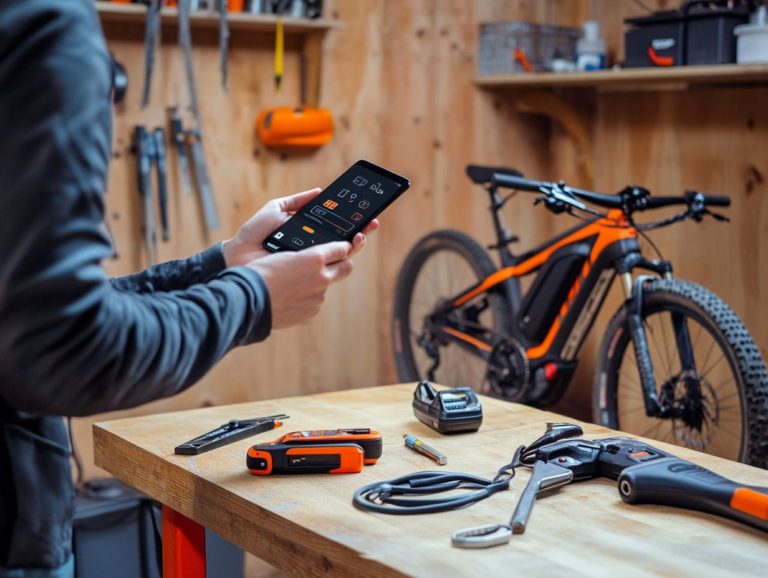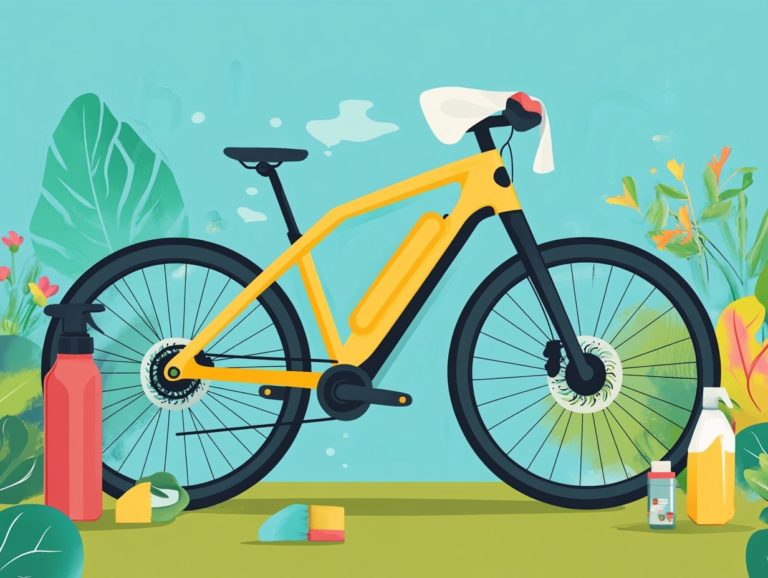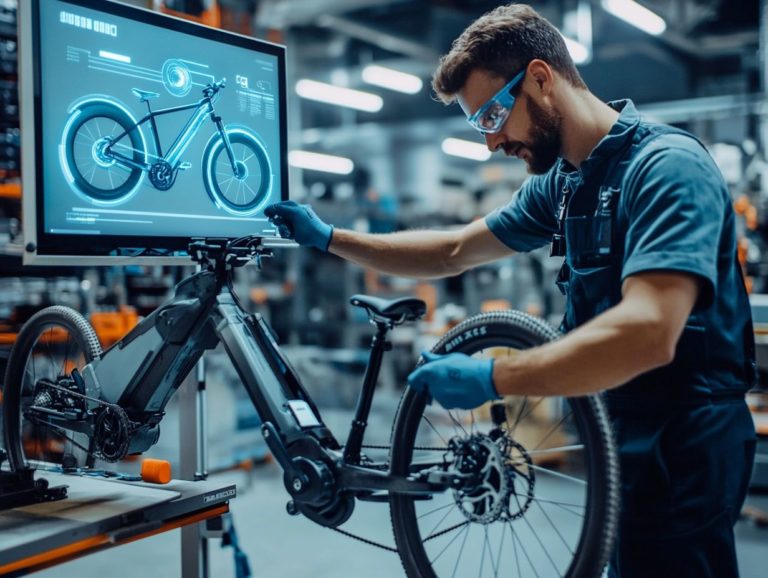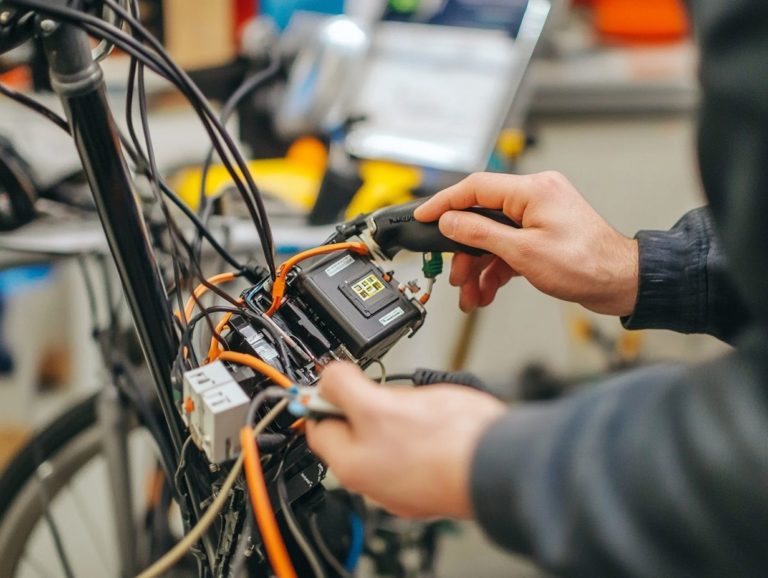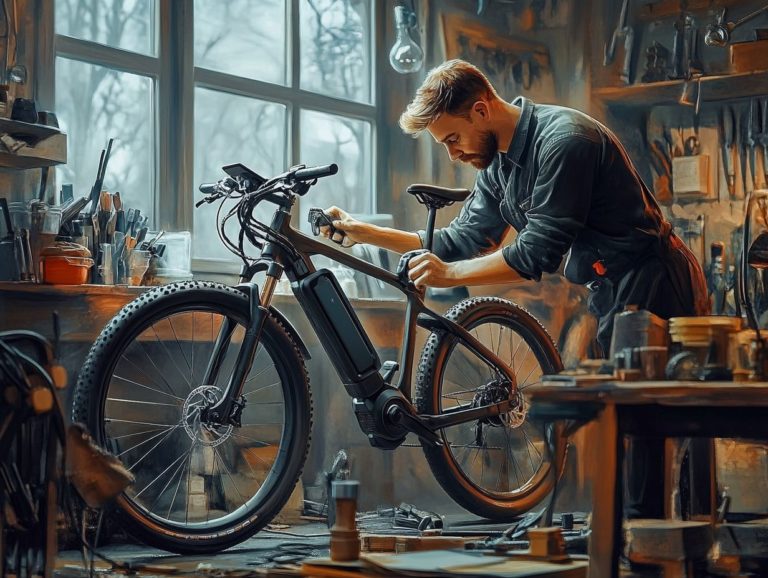How to Diagnose Electric Bicycle Speed Issues
Struggling with speed issues on your electric bicycle? You re certainly not the only one! Many riders encounter challenges that can detract from their cycling experience.
Let’s dive in and explore how to pinpoint speed issues!
This article will help you recognize the common causes behind these speed problems and walk you through a comprehensive diagnosis.
You ll find practical solutions, from adjusting your tire pressure to inspecting your battery and wiring. You’ll also learn essential maintenance tips to ensure your e-bike runs like a dream.
Contents
- Key Takeaways:
- Identifying the Problem
- Diagnosing Electric Bicycle Speed Issues
- Common Solutions for Speed Issues
- Preventing Speed Issues
- Frequently Asked Questions
- What are some common speed issues with electric bicycles?
- Wondering why your electric bike isn t accelerating fast enough?
- What can cause inconsistent or jerky speed on an electric bicycle?
- Why does my electric bicycle suddenly drop in speed while riding?
- How do I check the battery level on an electric bicycle?
- If I can t diagnose or fix the speed issue, what should I do?
Key Takeaways:
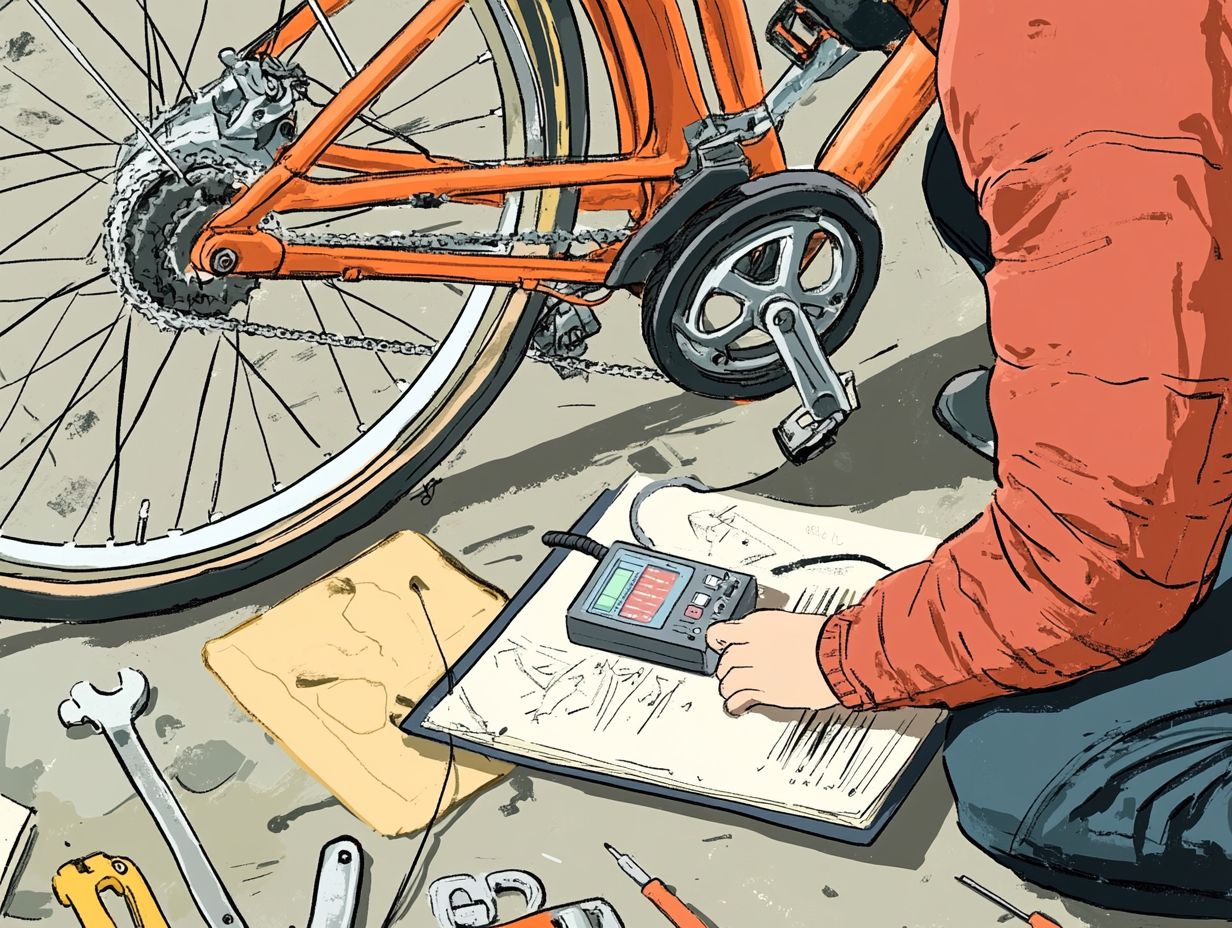
- Regular maintenance and care can prevent speed issues on your electric bicycle.
- Common causes of speed issues include tire pressure, battery and motor problems, e-bike controller malfunctions, and issues with wiring and connections.
- Identifying the problem and following a step-by-step diagnosis process can help pinpoint the cause of speed issues on your electric bicycle.
Identifying the Problem
Identifying the problem with your electric bike is essential for effective maintenance and ensuring a safe ride, especially when considering battery care. Issues can arise from various sources, such as battery errors, faulty electrical components, or complications with the e-bike controller.
Understanding these problems allows you to manage battery care effectively and prevent further damage. Whether you’re facing battery issues, a non-responsive throttle, or motor efficiency concerns, this guide helps you troubleshoot effectively!
Act now to familiarize yourself with potential problems to keep your ride safe and enjoyable!
Common Causes of Speed Issues
Speed issues in electric bikes often stem from underlying problems like battery care, motor efficiency, and issues with Shimano EP8 motors. You might notice sluggish acceleration or inconsistent performance, signaling the need for a thorough investigation of your e-bike’s battery errors.
Factors such as improper charging, battery errors, and electrical component malfunctions can all contribute to these challenges. Understanding these common culprits is crucial for effective troubleshooting and maintenance.
The condition of your bike’s tires, the weight you re carrying, and environmental factors like wind resistance and incline significantly influence performance. Ensuring that your tires are properly inflated optimizes grip and rolling resistance, ultimately aiding speed.
Regular maintenance of the drivetrain, including chains, gears, and electric components, is equally vital. A well-lubricated system allows for smoother transitions and minimizes energy loss.
By addressing these aspects and using proper troubleshooting electric bicycle throttle issues, you can enhance overall performance and enjoy a more satisfying ride!
Signs and Symptoms of Speed Issues
Identifying speed issues in your electric bike starts with recognizing distinct signs that something is wrong. You may suddenly feel your bike hesitate, which can be alarming! Look out for a noticeable dip in acceleration, unusual noises from the Shimano EP8 motors, or inconsistent pedal assist performance. A non-working throttle is also a key symptom. These issues could stem from various factors, like improper battery care, faulty wiring, or problems with the e-bike’s control system.
Other common signs include erratic throttle response, which may indicate issues with the throttle assembly or the electric drivetrain. You might also notice visible wear on parts like the chain or cassette, signaling resistance that can slow you down. Interruptions in power delivery could suggest a failure in the battery system, loose connections, or problems with electric components. Don t forget about tire pressure; under-inflated tires can make your bike feel sluggish.
By paying close attention to these symptoms, you can take proactive steps to keep your electric bike running smoothly and efficiently, including learning how to fix electric bicycle connectivity issues.
Diagnosing Electric Bicycle Speed Issues
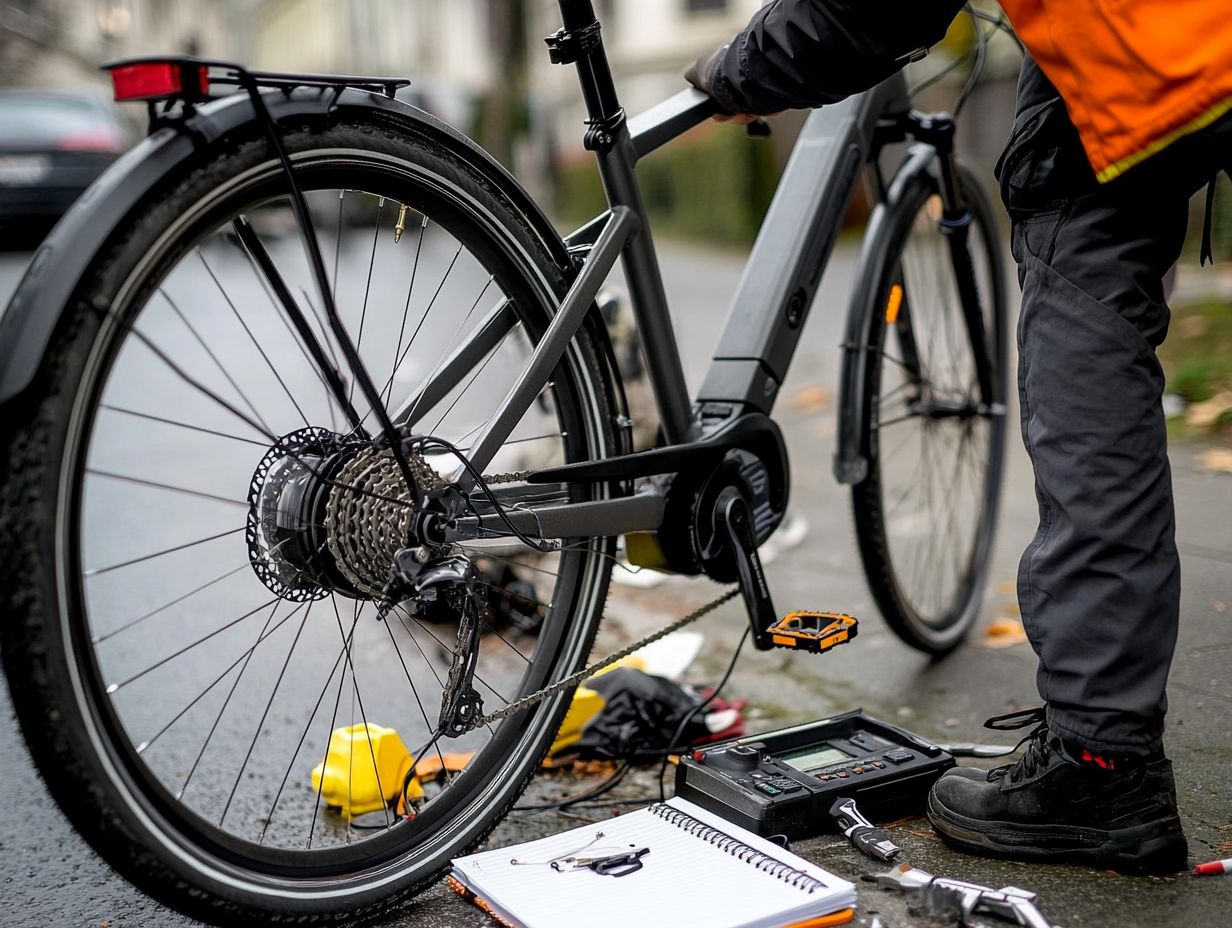
To find out what s slowing down your electric bike, you need to examine its parts carefully. Begin by reviewing your battery care practices; improper charging can significantly reduce motor efficiency. Next, check the e-bike controller, which manages the bike s overall performance.
Mastering the troubleshooting of these elements will help you achieve a comprehensive diagnosis of speed-related issues, guiding you toward necessary e-bike repairs, particularly when it comes to battery issues.
Steps to Determine the Cause
Start with e-bike troubleshooting techniques, focusing on possible battery errors affecting your performance. Examine the electric components, including the wiring and connectors; poor connections can cause significant problems. Watch for signs of wear or damage that may need repair.
To ensure a thorough diagnosis, check the battery voltage to confirm it’s within the expected range. If the battery appears faulty or undercharged, it may need replacing or could be under warranty. Also, inspect vital components like the motor, controller, and the magnetic charge port; signs of corrosion or loose connections could disrupt power delivery. For more detailed guidance, refer to this troubleshooting guide for electric bicycle electrical issues.
Don t overlook the tires and brakes. A visual inspection is crucial to ensure resistance isn t impeding acceleration. A test ride can help determine if the issue persists, allowing you to implement targeted solutions for optimal functionality.
Common Solutions for Speed Issues
When addressing speed issues in electric bikes, you have various solutions at your fingertips, from simple adjustments to more complex repairs, all designed to restore peak performance.
One of the simplest and most effective methods is to check your tire pressure; under-inflated tires can greatly hinder your speed. Also, pay attention to how you charge your e-bike. For more insights, refer to this guide on identifying electric bicycle performance issues. Avoid charging overnight; proper battery care enhances efficiency and extends lifespan.
By incorporating regular maintenance practices, you can preemptively tackle many of the speed-related challenges that may arise, ensuring your ride remains swift and enjoyable. Check your tire pressure today to ensure a speedy ride tomorrow!
Adjusting Tire Pressure
Adjusting tire pressure is vital for e-bike maintenance. It can greatly affect your speed. When you ensure your tires are inflated to the correct pressure, you not only boost your speed but also enhance overall handling and safety for your electric bike. Under-inflated tires create unnecessary drag, preventing your electric bike from achieving its full speed potential. In contrast, over-inflated tires can compromise traction and control. Regular checks and adjustments allow you to enjoy a smoother and more efficient ride!
To keep your performance at its peak, check your tire pressure routinely with a reliable gauge preferably before each ride. This ensures optimal conditions for your e-bike. Most e-bikes indicate a recommended pressure range, usually located on the tire sidewall or in the user manual.
Adjusting the pressure is straightforward just grab a pump or compressor. Keeping the right pressure not only boosts your speed and efficiency but also extends tire life and reduces the risk of flats.
In the end, regular tire maintenance and checks on electrical components enable you to experience a safer and more thrilling ride on your electric bike.
Checking Battery and Motor
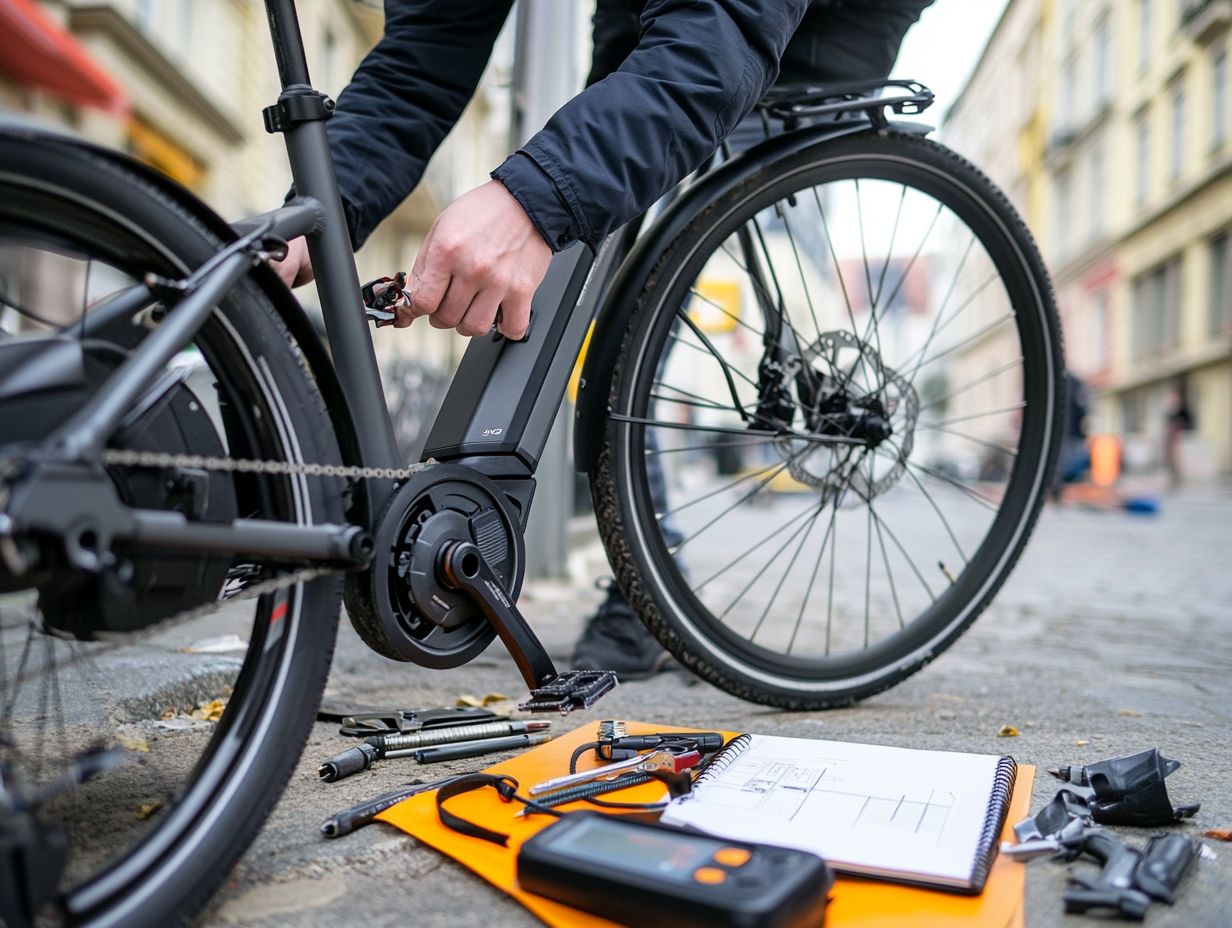
Check the battery and motor of your electric bike regularly to tackle speed issues and ensure top-notch performance. Evaluate your battery care routine, including how you charge your battery. A well-maintained battery directly impacts motor efficiency, affecting how your bike performs while riding. If you notice signs of wear or malfunction in the battery, it may need replacement or repair to regain that lost speed, especially if it’s under warranty.
Remove the battery from the frame and inspect its connections for dirt or corrosion; these little culprits can really hinder performance. Use a multimeter (a tool that measures electrical voltage) to test the voltage, giving you insight into its current condition. If the battery cells are imbalanced or not holding a charge, it can negatively affect the motor’s output, resulting in sluggish acceleration or a reduced range. For more details on addressing these issues, check out how to fix common electric bicycle noise problems.
Next, turn your attention to the motor. Listen for any unusual noises during operation and ensure everything is properly aligned and torqued on the motor mounts. Regular maintenance and timely checks will keep your battery and motor in top shape, allowing you to savor smooth and efficient rides.
Inspecting Wiring and Connections
Inspecting the wiring and connections in your electric bike is essential for diagnosing speed issues effectively. Faulty or damaged wiring can disrupt communication between the electric components, leading to sluggish performance or even total system failure. Regular inspections are a key part of e-bike maintenance that can help you avoid these escalating problems. Ensure that all connections are secure and free from corrosion to maintain optimal functionality.
Taking the time to thoroughly check your electrical components, such as the battery, controller, and motor connections, can save you from unexpected breakdowns and unsafe riding experiences. To understand potential issues better, refer to the most common electric bicycle problems explained. Follow this simple checklist to keep your e-bike in top condition:
- Check battery terminals for tightness and rust.
- Examine wiring for any wear and tear.
- Inspect connectors to ensure they’re secure.
- Confirm all electrical components are functioning.
Following this checklist not only enhances your safety but also extends the lifespan of your e-bike.
Preventing Speed Issues
Preventing speed issues in your electric bike revolves around proactive maintenance and care practices that guarantee optimal performance and reliability. Engaging in regular e-bike maintenance routines such as diligent battery care and proper charging habits is crucial for sidestepping future complications.
Furthermore, storing your electric bike correctly safeguards its components from environmental factors that could lead to deterioration. Familiarizing yourself with your e-bike warranty will also enable you to maintain the bike effectively, ensuring you re protected against any unforeseen issues that may arise.
Don’t wait! Regular checks are crucial for a safe ride!
Maintenance and Care Tips
Effective maintenance can enhance your electric bike‘s longevity. It also improves speed performance.
Regularly check battery care practices, such as proper charging and storage, to maintain the battery’s condition. Storing your bike in a dry, temperature-controlled environment safeguards it from the elements and protects vital electrical components.
Familiarizing yourself with the e-bike warranty can inform your maintenance approach and guide necessary repairs. Monitor tire pressure consistently and check brake function to enhance your riding experience and ensure safety on the road. If you encounter any issues with your display, refer to this guide on troubleshooting electric bicycle display issues for assistance.
Cleaning the bike frame and drivetrain components is essential; it helps prevent rust and wear that can impact performance over time. Keeping an eye on software updates and maintaining connectivity with smartphone apps provides valuable insights into your bike’s overall performance metrics.
Schedule regular professional tune-ups for deeper inspections and adjustments. This ensures everything functions optimally and prolongs the life of your e-bike.
Frequently Asked Questions
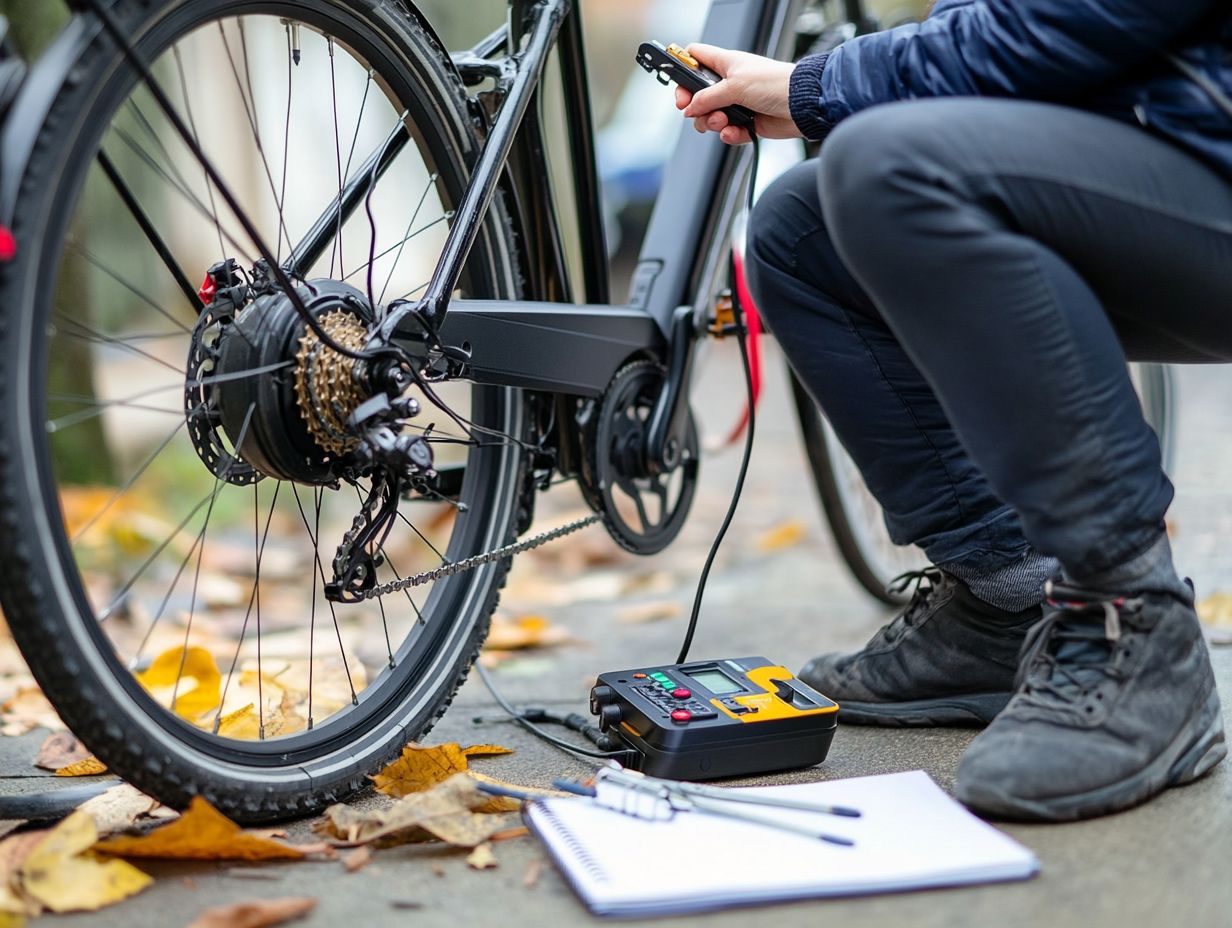
What are some common speed issues with electric bicycles?
Common speed issues include slow acceleration, inconsistent speed, and sudden drops in speed while riding.
Wondering why your electric bike isn t accelerating fast enough?
Start by checking the battery level and ensure it is fully charged. If it is, check the motor to make sure it s functioning properly. If the motor works fine, the issue may lie with the controller or wiring.
What can cause inconsistent or jerky speed on an electric bicycle?
Inconsistent or jerky speed can stem from a variety of issues, such as a loose or damaged motor, a malfunctioning controller, or a faulty connection in the wiring. It s best to consult a professional to determine the exact cause and necessary repairs.
Why does my electric bicycle suddenly drop in speed while riding?
If your bike suddenly drops in speed, it could be due to a weak or dying battery. Check the battery level to ensure it s fully charged. If it is, the issue may be with the motor, controller, or wiring.
How do I check the battery level on an electric bicycle?
To check the battery level, locate the battery pack and look for a display or button. Press the button or check the display to see the current battery level. If low, charge the battery before riding.
If I can t diagnose or fix the speed issue, what should I do?
If you can’t diagnose or fix the issue, it s best to consult a professional. They have the expertise and tools to accurately assess and repair your bike, ensuring it runs smoothly and safely.


